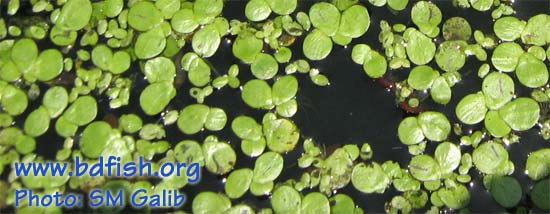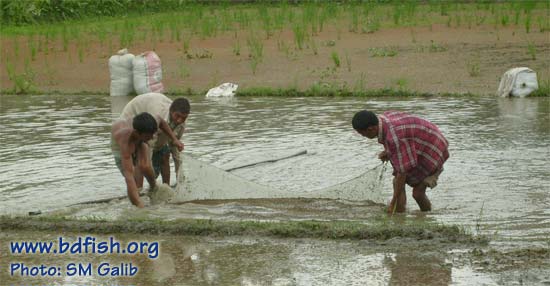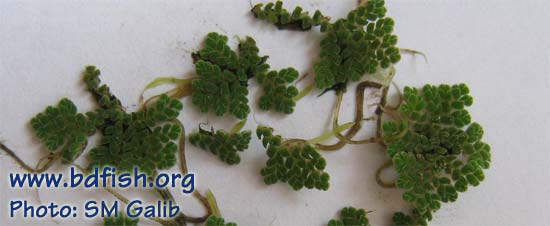
Duck weeds are the group of floating plants belonging to the genera Lemna, Azolla and Wolffia (Singh and Mittal, 1999). But Das (1997) mentioned Lemna, Spirodela, Wolffia and Wolffiella genus as duck weeds. So far, a total of 34 species of duck weeds have been identified from different parts of the world (Das, 1997).
Local names: Duck weed species are world-wide distributed and these are commonly known as “Kutipana” (কুটিপানা) in Bangladesh (Das, 1997). However, many other local names of these duck weeds are identified from Bangladesh, e.g. khudipana (ক্ষুদিপানা), topapana (টোপাপানা), tilakpana (তিলকপানা), guripana (গুড়িপানা), ulkipana (উলকিপানা), endurkanipana (ইন্দুরকানিপানা), sonapana (সোনাপানা), tetulipana (তেতুলিপানা) and sujipana (সুজিপানা).
Availability of duck weeds in Bangladesh: Various species of duck weeds naturally grow in ponds, ditches, canals, burrow pits, inundated agricultural fields, floodplains and other freshwater bodies of Bangladesh. There are about 6 species of duck weeds in Bangladesh (Grover et al, 2000; Samad, 2010) but specific list of these duck weeds are not found.

Importance of duck weeds: Research findings and experience have shown that duck weeds can be used as food for both fishes and livestock (Grover et al, 2000). Moreover, the land, water, weather and climate are very much suitable for culture of duck weeds (Grover et al, 2000). Duck weed may contain up to 45% protein (dry condition) depending on environment and species (Grover et al, 2000; Samad, 2010). However, by supplying high protein containing to herbivore fishes, high production can be achieved with low lost investment.
Nutrient contents: According to Das (1997) nutritional composition of various species of duck weeds are as follows (dry weight)- protein (6.8-45%), lipid (1.8-9.2%), crude fiber (5.7-16.2), carbohydrate (14.1-43.6%), ash (12-27.6%) and fat (1-8%).
However, live or fresh duck weed contains 90-96% water (Das, 1997). 23.5% of protein and 44.2% of minerals of total amount protein and minerals present in the duck weed are easily digestible (Das, 1997). Duck weeds also contain vitamin A, B1, B2, B6, C, E and PP (Das, 1997).
Composition of Spirodela (g/kg dry matter): Dry matter – 825, ash – 175, crude protein – 284, neutral detergent fiber – 471, acid detergent fiber – 215, hemi-cellulose – 256 and lignin – 32.6 (Haque et al., 1996).
Composition of Lemna (g/kg dry matter): Dry matter – 883, ash – 176, crude protein – 339, neutral detergent fiber – 574, acid detergent fiber – 203 and hemi-cellulose – 371 (Haque et al., 1996).
Composition of Wolffia (g/kg dry matter): Dry matter – 865, ash – 156, crude protein – 299, neutral detergent fiber – 476, acid detergent fiber – 227, hemi-cellulose – 249 and lignin – 12.6 (Haque et al., 1996).
Suitable duck weeds for aquaculture: Three species of duck weeds (Spirodela polyrriza, Lemna minor and Wolffia orrhiza) have been identified by Prism Bangladesh (Sobuj Sena Project) suitable for culture and aquaculture (Das, 1997). Similar findings are also mentioned by Grover et al. (2000). Azolla is also very much suitable for aquaculture.

Several duck weed species profile
Spirodela polyrriza
local name: Sonapana (সোনাপানা)
Characteristics: Leaves are flat or oval, 6-10.5 mm in length, 5-10 mm wide and 0.6-1.5 mm thick (Das, 1997). Deep green above but with deep brown/reddish ventral. It contains 10-15 roots which are 10-40 mm long (Das, 1997).
Lemna minor
local name: Tetulipana (তেতুলিপানা)
Characteristics: Leaves are flat and elongated, like tamarind tree leaves, 3-4.5 mm in length, 2-2 mm wide and 0.2-0.3 mm thick (Das, 1997). Deep green or green in color. It contains single root which is 10-15 mm long (Das, 1997).
Wolffia arrhiza
local name: Sujipana (সুজিপানা) and Dimpana (ডিমপানা)
Characteristics: Leaves are minute and rounded, 0.6-1.2 mm in length and 0.5-1 mm wide (Das, 1997). Deep green in color and without roots (Das, 1997).
Azolla pinnata
local name: Azolla (এ্যাজোলা)
Characteristics: Newly form leaves are green but aged leaves are brown in color. With roots.
__________________________________________________________
REFERENCES
Das B (1997) Fisheries and Fisheries Resources Management Vol. III, Bangla Academy, Dhaka, Bangladesh, pp. 177-202.
Grover JH, Islam MA, Shah WA, Rana MAH and Chowdhury HA (2000) Training Manual for Extension Personnel on Low-Cost Environment Friendly Sustainable Aquaculture Practices Thoroughly Revised and Enlarged Second Edition, International Center for Living Aquatic Resources Management, Dhaka, Bangladesh, pp. 33-38 (in Bengla).
Haque KS, Chowdhury SA and Kibria SS (1996) Study on the potentiality of Duckweeds as a Feed for Cattle, AJAS 9(2): 133-137.
Samad MA (2010) Dictionary of Fisheries, Kabir Publications, Dhaka, Bangladesh, p. 87.
Singh AK and Mittal A (1999) Dictionary of Aquaculture, Daya Publishing House, Delhi, India, p. 67.
Visited 3,832 times, 2 visits today | Have any fisheries relevant question?
